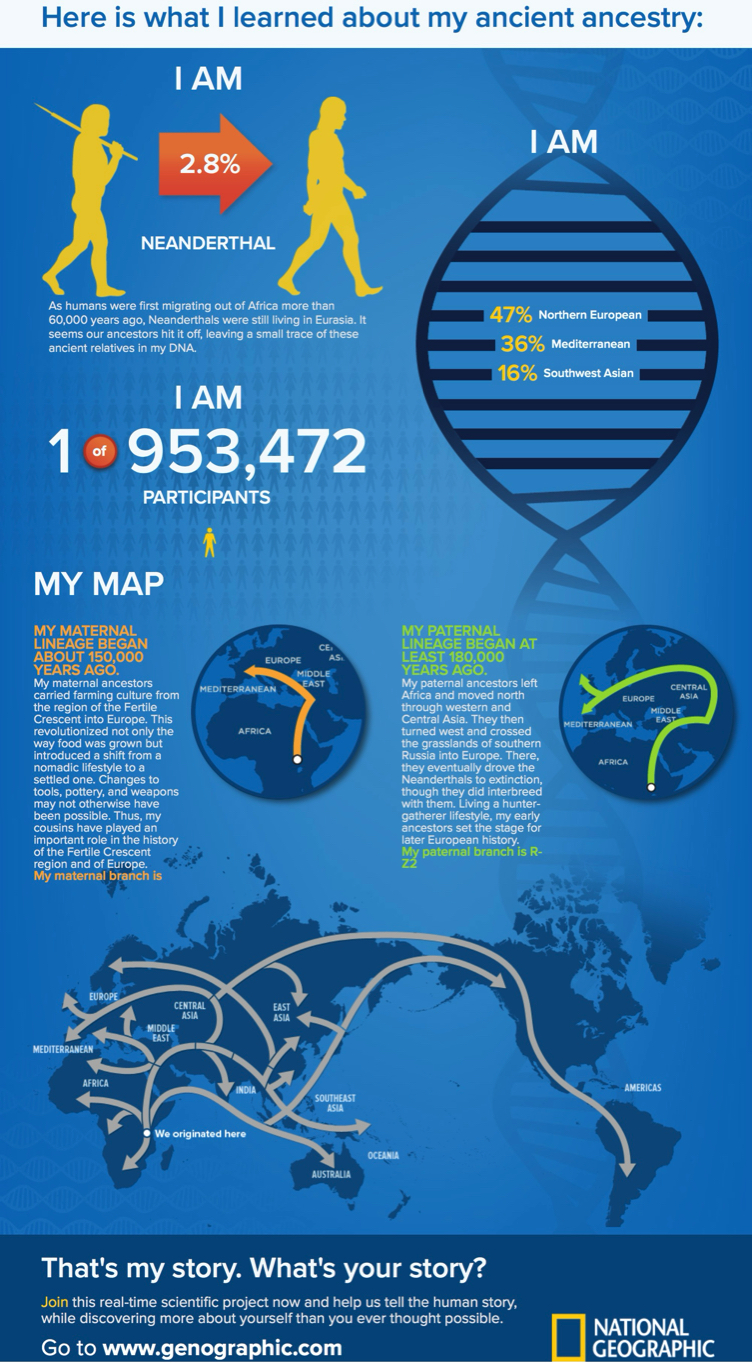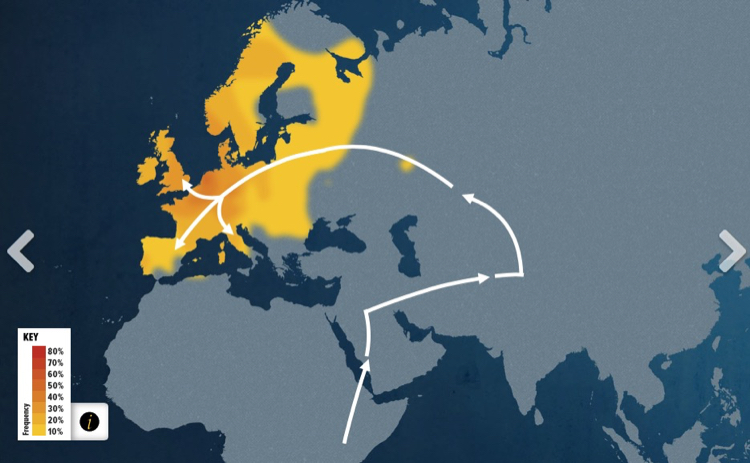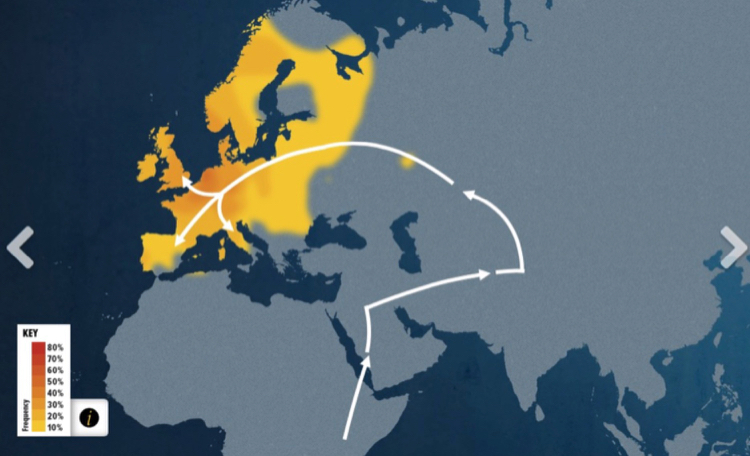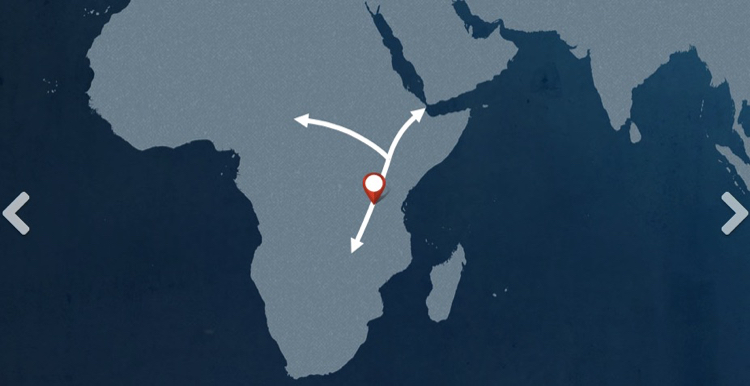
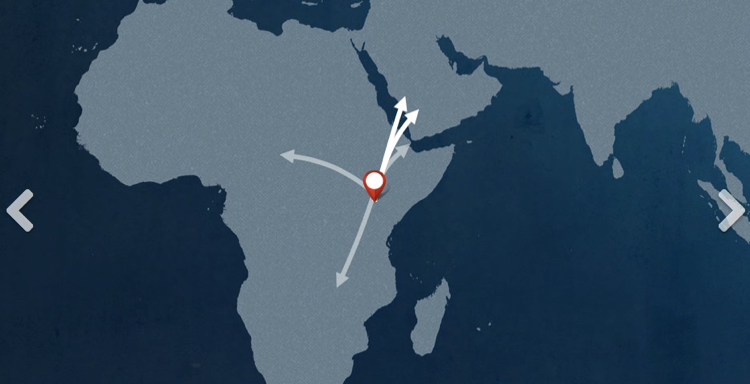
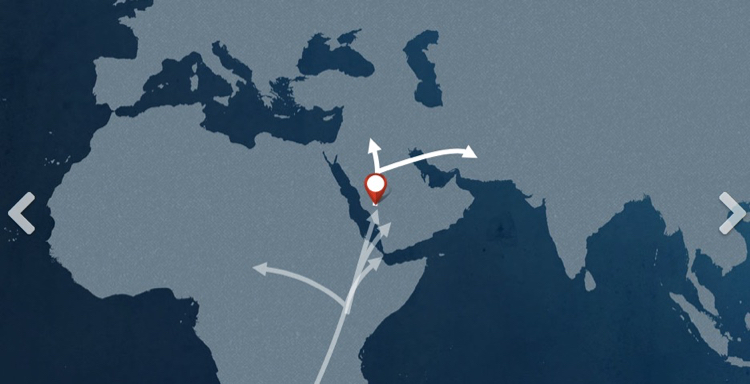
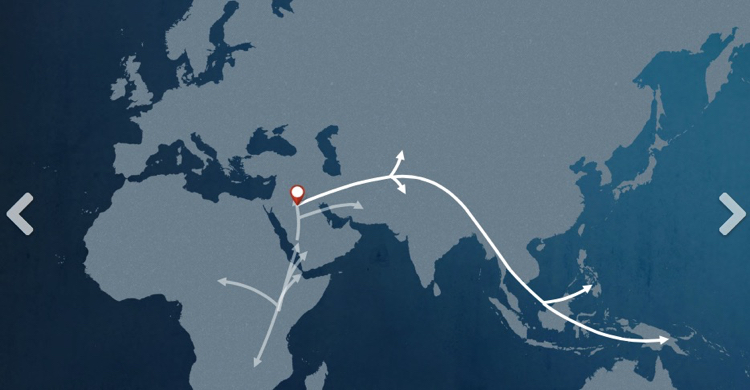
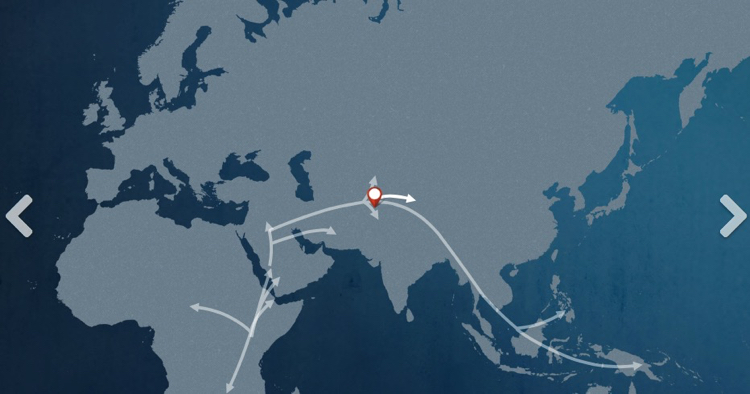
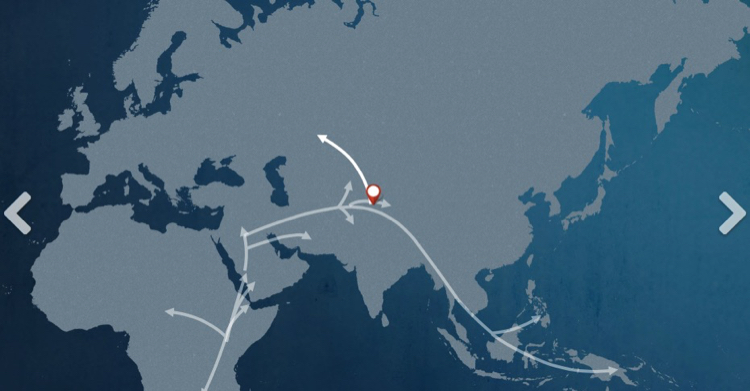
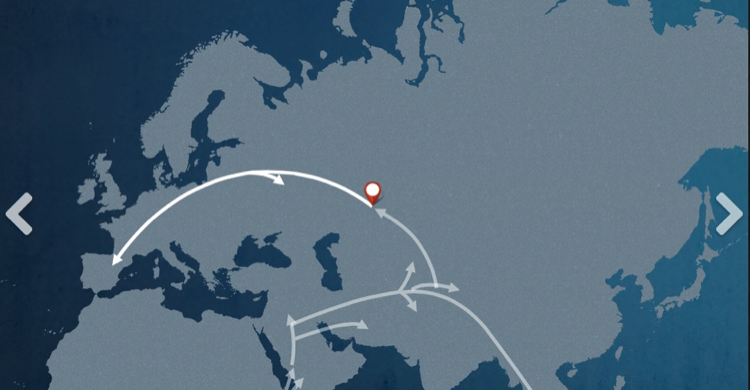
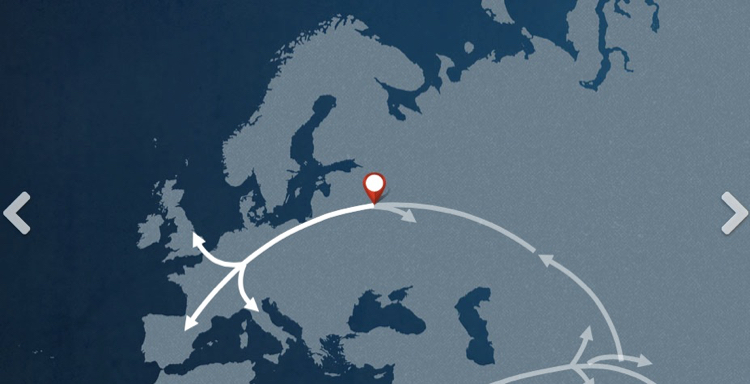
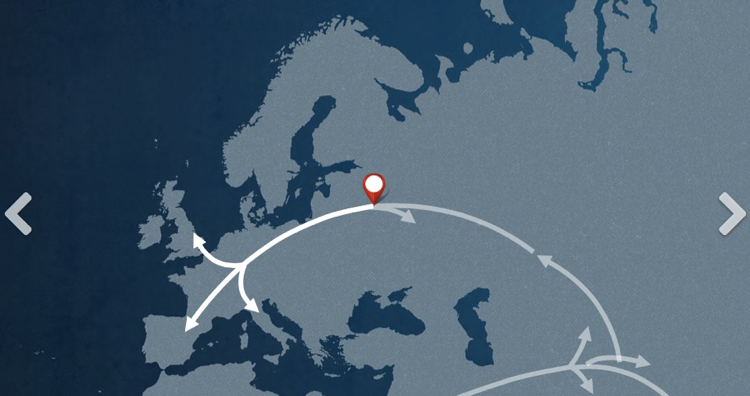
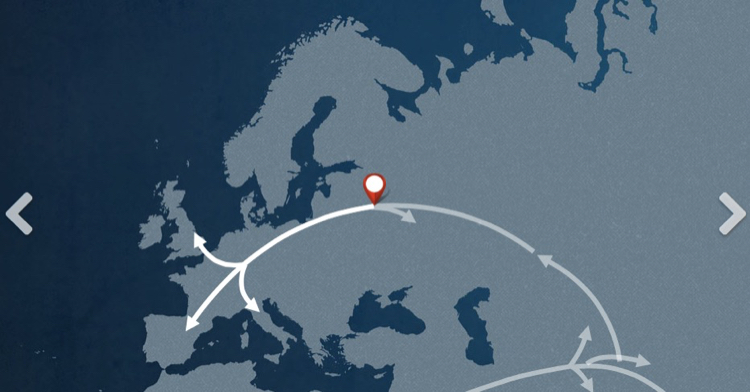
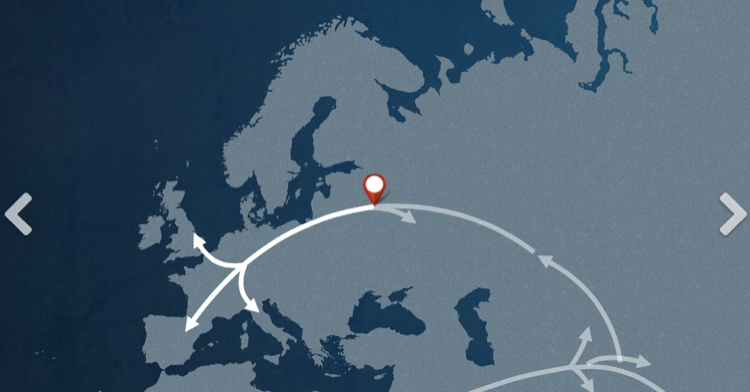
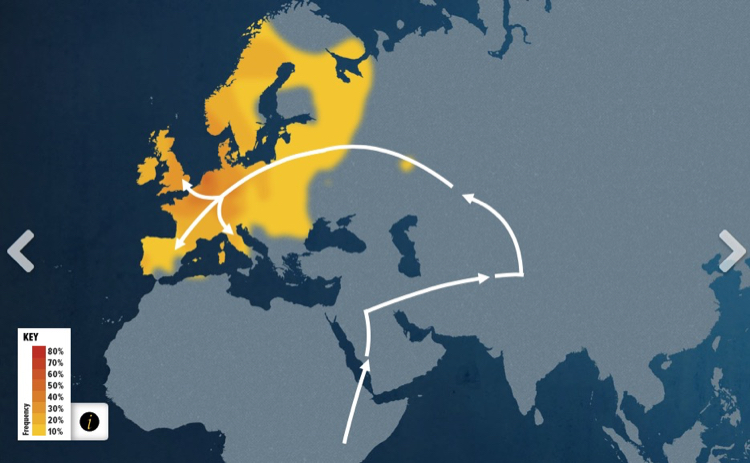
INTRODUCTION TO OUR STORY
Taken From DNA Testing by “The Genographic Project”
Results for Brashears Paternal Line
DNA Doner: Mel R. Brashears
The 75,000 year Migration Path of the Brashears Paternal Line
Our direct paternal ancestor was born in the Rift Valley of eastern Africa about 75,000 years ago probably in modern day Kenya. The earliest known Brashears was Robert Brasseur, born ca 1575 in Bouches-du-Rhône, Provence-Alpes-Côte d'Azur in France.
The Journey
BRANCH: M42
AGE: ABOUT 75,000 YEARS AGO
LOCATION OF ORIGIN: AFRICA
The common direct paternal ancestor of all men alive today was born in Africa around 140,000 years ago. Dubbed “Y-chromosome Adam” by the popular press, he was neither the first human male nor the only man alive in his time. He was, though, the only male whose Y-chromosome lineage is still around today. All men, including your direct paternal ancestors, trace their ancestry to one of this man's descendants. The oldest Y-chromosome lineages in existence, belonging to the A branch of the tree, are found only in African populations.
Around 75,000 years ago, the BT branch of the Y-chromosome tree was born, defined by many genetic markers, including M42. The common ancestor of most men living today, some of this man's descendants would begin the journey out of Africa, to India and the Middle East. Small groups would eventually reach the Americas. Others would settle in Europe, and some from this line remained near their ancestral homeland in Africa.
Individuals from this line in Africa often practice cultural traditions that resemble those of their distant ancestors. For example, they often live in traditional hunter-gatherer societies. These include the Mbuti and Biaka Pygmies of central Africa, as well as Tanzania's Hadza.
As M42-bearing populations migrated around the globe, they picked up additional markers on their Y-chromosomes. Today, there are no known BT individuals without these additional markers.
POINT OF INTEREST
The M42 branch is shared by almost all men alive today, both in Africa and around the world.
BRANCH: M168
AGE: ABOUT 70,000 YEARS AGO
LOCATION OF ORIGIN: AFRICA/ASIA
As humans left Africa, they migrated across the globe in a web of paths that spread out like the branches of a tree, each limb of migration identifiable by a marker in our DNA. For male lineages, the M168 branch was one of the first to leave the African homeland.
Moving outward from Africa and along the coastline, members of this lineage were some of the earliest settlers in Asia, Southeast Asia, and Australia. Some from this line would even travel over the land bridge to reach the Americas.
The man who gave rise to the first genetic marker in your lineage probably lived in northeast Africa in the region of the Rift Valley, perhaps in present-day Ethiopia, Kenya, or Tanzania. Scientists put the most likely date for when he lived at around 70,000 years ago. His descendants became the only lineage to survive outside of Africa, making him the common ancestor of every non-African man living today.
But why would man have first ventured out of the familiar African hunting grounds and into unexplored lands? The first migrants likely ventured across the Bab-al Mandeb strait, a narrow body of water at the southern end of the Red Sea, crossing into the Arabian Peninsula soon after M168 originated—perhaps 65,000 years ago. These beachcombers would make their way rapidly to India and Southeast Asia, following the coastline in a gradual march eastward. By 50,000 years ago, they had reached Australia. These were the ancestors of today's Australian Aborigines.
It is also likely that a fluctuation in climate may have contributed to your ancestors' exodus out of Africa. The African ice age was characterized by drought rather than by cold. Around 50,000 years ago, though, the ice sheets of the northern hemisphere began to melt, introducing a short period of warmer temperatures and moister climate in Africa and the Middle East. Parts of the inhospitable Sahara briefly became habitable. As the drought-ridden desert changed to a savanna, the animals hunted by your ancestors expanded their range and began moving through the newly emerging green corridor of grasslands.
Your nomadic ancestors followed the good weather and the animals they hunted, although the exact route they followed remains to be determined. In addition to a favorable change in climate, around this same time there was a great leap forward in modern humans' intellectual capacity. Many scientists believe that the emergence of language gave us a huge advantage over other early human species. Improved tools and weapons, the ability to plan ahead and cooperate with one another, and an increased capacity to exploit resources in ways we hadn't been able to earlier, all allowed modern humans to rapidly migrate to new territories, exploit new resources, and replace other hominids such as the Neanderthals.
POINT OF INTEREST
This male branch is one of the first to leave the African homeland.
BRANCH: M89
AGE: AROUND 50,000 YEARS AGO
LOCATION OF ORIGIN: SOUTH ASIA OR WEST ASIA
The next male ancestor in your ancestral lineage is the man who gave rise to M89, a marker found in 90 to 95 percent of all non-Africans. This man was born around 50,000 years ago in northern Africa or the Middle East.
The first people to leave Africa likely followed a coastal route that eventually ended in Australia. Your ancestors followed the expanding grasslands and plentiful game to the Middle East and beyond, and were part of the second great wave of migration out of Africa.
Beginning about 40,000 years ago, the climate shifted once again and became colder and more arid. Drought hit Africa and the grasslands reverted to desert, and for the next 20,000 years, the Saharan Gateway was effectively closed. With the desert impassable, your ancestors had two options: remain in the Middle East, or move on. Retreat back to the home continent was not an option.
While many of the descendants of M89 remained in the Middle East, others continued to follow the great herds of wild game through what is now modern-day Iran to the vast steppes of Central Asia.
These semi-arid grass-covered plains formed an ancient “superhighway” stretching from eastern France to Korea. Your ancestors, having migrated north out of Africa into the Middle East, then traveled both east and west along this Central Asian superhighway. A smaller group continued moving north from the Middle East to Anatolia and the Balkans, trading familiar grasslands for forests and high country.
Today, geneticists have found the lineage in 1 to 2 percent of Pakistani and Indian populations. However, it is about 4 percent of some Austro-Asiatic-language-family-speaking groups in India. It is about 9 percent of some Dravidian-language-family-speaking groups in India, and it is 9 to 10 percent of male lineages in Sri Lanka. In Borneo, it is about 5 percent of the population. In Malaysia, it is about 6 percent of the population.
BRANCH: P128
AGE: ABOUT 45,000 YEARS AGO
LOCATION OF ORIGIN: SOUTH ASIA
The next male ancestor in your ancestral lineage is the man who gave rise to P128, a marker found in more than half of all non-Africans alive today. This man was born around 45,000 years ago in the Middle East or Central Asia.
The descendants of P128 migrated to the east and north, picking up additional markers on their Y-chromosomes. This lineage is the parent of several major branches on the Y-chromosome tree: O, the most common lineage in East Asia; R, the major European Y-chromosome lineage; and Q, the major Y-chromosome lineage in the Americas. These descendant branches went on to settle the rest of Asia, the Americas, and Europe; many others traveled to Southeast Asia.
Today, P128 individuals lacking these additional markers are rare in most populations, and are most commonly seen in Oceanian and Australian Aboriginal populations.
BRANCH: M45
AGE: AROUND 35,000 YEARS AGO
LOCATION OF ORIGIN: CENTRAL ASIA OR SOUTH ASIA
This paternal ancestor traveled with groups in the open savannas between Central and South Asia during the Paleolithic. These big game hunters were the parents to two of the most widespread male lineages in modern populations, one that is responsible for the majority of pre-Columbian lineages in the Americas (haplogroup Q) and many others from Asia and Europe. Another one that spread farther into Asia produced the highest frequency lineages in European populations (haplogroup R).
Today, members of this lineage who do not belong to a descendant branch are rare, and geneticists have found them most often in India. These populations include such diverse groups as the Saora (23 percent), the Bhumij (13 percent), and Muslims from Manipur (33 percent).
BRANCH: M207
AGE: ABOUT 30,000 YEARS AGO
LOCATION OF ORIGIN: CENTRAL ASIA
M207 was born in Central Asia around 30,000 years ago. His descendants would go on to settle in Europe, South Asia and the Middle East over the following 20,000 years. Today, most western European men belong to one branch—R-M342—that descended from this lineage. While it appears to have been one of the earliest lineages to settle in Europe more than 25,000 years ago, more recent population expansions associated with the post-glacial repopulation of northern Europe after the end of the last ice age, as well as the spread of agriculture during the Neolithic, also contributed to its high frequency in Ireland, the UK, France and Spain.
One descendant lineage—R-L62—is common in Eastern Europe and India, and was likely spread in part through the migration of Indo-European steppe nomads over the past 5,000 years.
BRANCH: P231
AGE: 25,000 – 30,000 YEARS AGO
LOCATION OF ORIGIN: CENTRAL ASIA
The Paleolithic ancestor who founded this lineage lived a nomadic lifestyle. His descendants include two major descendant branches that today account for most European men and many others from Central Asia, West Asia, and South Asia.
BRANCH: M343
AGE: 17,000 – 22,000 YEARS AGO
LOCATION OF ORIGIN: SOUTH ASIA OR WEST ASIA
The first members of this lineage lived as hunter-gatherers on the open savannas that stretched from Korea to Central Europe. They took part in the advances in hunting technology that allowed for population growth and expansions.
When the Earth entered a cooling phase, most from this line sheltered in refugia to the southeast of Europe and in West Asia. It was from these refugia that their populations rapidly expanded when the ice once more receded. Some traveled west across Europe. Others moved back toward their distant ancestors' homelands in Africa, passing through the Levant region. Through these movements and the population boom triggered by the Neolithic Revolution, this lineage and its descendant lineages came to dominate Europe.
Today, it has a wide distribution. In Africa, geneticists have found this lineage in Northern Africa (6 percent) and central Sahel (23 percent). Its frequency in Europe is at times high and at other times moderate. It represents about 7 percent of Russian male lineages, about 13 percent of male lineages in the Balkans, about 21 percent of Eastern European male lineages, 55 to 58 percent of Western European lineages, and about 43 percent of Central European male lineages. In Asia, most men of this lineage are found in West Asia (6 percent) and South Asia (5 percent). However, trace frequencies of around half a percent from this lineage are present in East Asia.
NOTABLE PEOPLE
Russian Emperor Nicholas II belonged to this lineage.
BRANCH: L278
AGE: TO BE DETERMINED
LOCATION OF ORIGIN: WEST ASIA
While some from this group traveled west into Central Asia, others moved south toward the Levant region. Today, they are present in trace frequencies of less than 1 percent in Italy, the Ukraine, and the region of the Pannonian Basin.
Note: This branch is not accompanied by a major movement on the map, and research on this branch is continuing.
POINT OF INTEREST
Those who belong to this lineage but do not belong to a descendant branch are rare.
BRANCH: P310
AGE: TO BE DETERMINED
LOCATION OF ORIGIN: WEST ASIA
Members of this lineage have traveled to Central Asia, Europe, and the Levant region. One descendant branch has the highest frequency of any male line in Western Europe. However, rather than a single movement across Europe, this lineage's branches may represent many simultaneous and successive waves of migration.
Today, it is 48 to 52 percent of male lineages in Ireland. It is 45 percent of those in France. It is about 38 percent of the male population in Spain. It is about 8 percent of male lineages in Italy. It is about 5 percent of male lineages in Oman. It is 1 to 2 percent of the male population in Iraq and Lebanon. It is also 1 to 2 percent of the male population in Kazakhstan.
Note: This branch is not accompanied by a major movement on the map, and research on this branch is continuing.
BRANCH: U106
AGE: 4,250 – 14,000 YEARS AGO
LOCATION OF ORIGIN: EUROPE
Members of this lineage have expanded into the rest of Europe and back into parts of West Asia in the last 10,000 years.
Today, geneticists have found it and its descendant branches at moderate to high frequencies throughout Europe and occasionally in West Asia. The highest frequencies are in the Netherlands (14 percent), Luxembourg (13 percent), and Belgium (12 percent). In the British Isles, it is between 6 and 9 percent of the male population. It is about 5 percent of male lineages in Oman. It is 4 to 5 percent of the male population in Cyprus. It is 1 to 2 percent of male lineages in Italy and Spain.
Note: This branch is not accompanied by a major movement on the map, and research on this branch is continuing.
HEATMAP FOR U106
This next step in your journey is a map showing the frequency of your haplogroup (or the closest haplogroup in your path that we have frequency information for) in indigenous populations from around the world, providing a more detailed look at where your more recent ancestors settled in their migratory journey. What do we mean by recent? It's difficult to say, as it could vary from a few hundred years ago to a few thousand years ago depending on how much scientists currently know about your particular haplogroup. As we test more individuals and receive more information worldwide, this information will grow and change.
The colors on the map represent the percentage frequency of your haplogroup in populations from different geographic regions—red indicates high concentrations, and light yellow and grey indicate low concentrations. The geographic region with the highest frequency isn't necessarily the place where the haplogroup originated, although this is sometimes the case.
The map of U106 shows a distribution in Europe that peaks in Western Europe where it experienced successful expansions, particularly after the end of the last ice age with the recolonization of northern Europe.
Are you related to people in the areas highlighted on your map? Distantly, yes—we are all connected through our ancient ancestry.
****************************************************************************************************************************************
Taken From DNA Testing by “The Genographic Project”
Results for Gail Curtis Dollins Maternal Line
The 70,000 year Migration Path of the Gail Curtis Dollins Maternal Line
The Journey
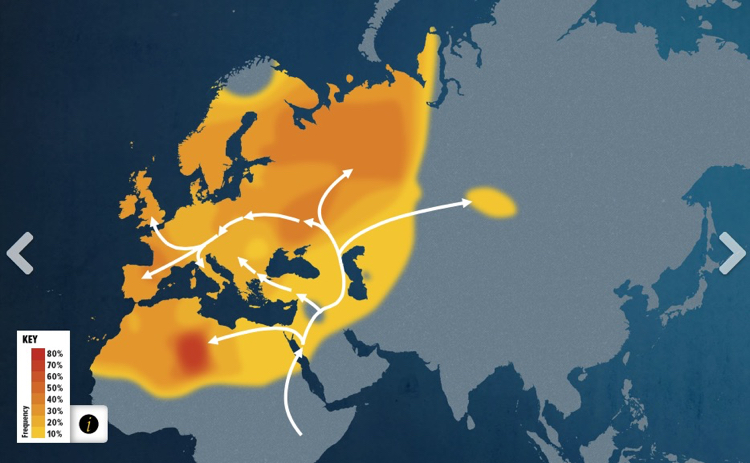
BRANCH: N
AGE: ABOUT 60,000 YEARS AGO
LOCATION OF ORIGIN: EAST AFRICA OR ASIA
Your next ancestor is the woman whose descendants formed haplogroup N. Haplogroup N comprises one of two groups that were created by the descendants of L3.
One of these two groups of individuals moved north rather than east and left the African continent across the Sinai Peninsula, in present-day Egypt. Also faced with the harsh desert conditions of the Sahara, these people likely followed the Nile basin, which would have proved a reliable water and food supply in spite of the surrounding desert and its frequent sandstorms.
Descendants of these migrants eventually formed haplogroup N. Early members of this group lived in the eastern Mediterranean region and western Asia, where they likely coexisted for a time with other hominids such as Neanderthals. Excavations in Israel's Kebara Cave (Mount Carmel) have unearthed Neanderthal skeletons as recent as 60,000 years old, indicating that there was both geographic and temporal overlap of these two hominids. This likely accounts for the presence of Neanderthal DNA in people living outside of Africa.
Some members bearing mutations specific to haplogroup N formed many groups of their own which went on to populate much of the rest of the globe. These descendants are found throughout Asia, Europe, India, and the Americas. However, because almost all of the mitochondrial lineages found in the Near East and Europe descend from N, it is considered a western Eurasian haplogroup.
After several thousand years in the Near East, members of your group began moving into unexplored nearby territories, following large herds of migrating game across vast plains. These groups broke into several directions and made their way into territories surrounding the Near East.
Today, haplogroup N individuals who headed west are prevalent in Turkey and the eastern Mediterranean, they are found further east in parts of Central Asia and the Indus Valley of Pakistan and India. And members of your haplogroup who headed north out of the Levant across the Caucasus Mountains have remained in southeastern Europe and the Balkans. Importantly, descendants of these people eventually went on to populate the rest of Europe, and today comprise the most frequent mitochondrial lineages found there.
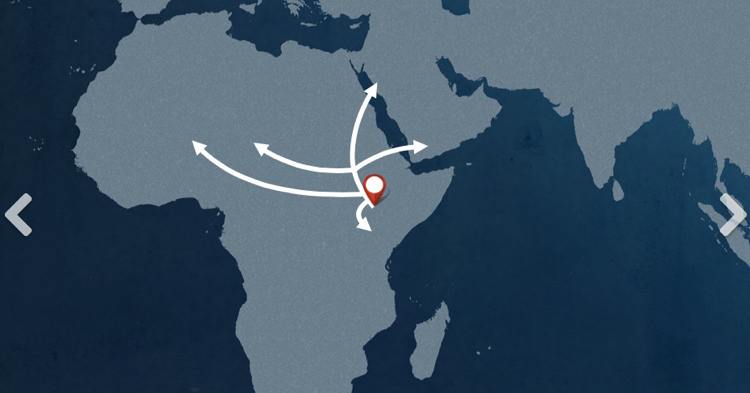
BRANCH: L3
AGE: 67,000 YEARS AGO
LOCATION OF ORIGIN: EAST AFRICA
This woman's descendants would eventually account for both out-of-Africa maternal lineages, significant population migrations in Africa, and even take part in the Atlantic Slave Trade related dispersals from Africa.
The common direct maternal ancestor to all women alive today was born in East Africa around 180,000 years ago. Dubbed “Mitochondrial Eve” by the popular press, she represents the root of the human family tree. Eve gave rise to two descendant lineages known as L0 and L1'2'3'4'5'6, characterized by a different set of genetic mutations their members carry.
Current genetic data indicates that indigenous people belonging to these groups are found exclusively in Africa. This means that, because all humans have a common female ancestor, and because the genetic data shows that Africans are the oldest groups on the planet, we know our species originated there.
Eventually, L1'2'3'4'5'6 gave rise to L3 in East Africa. It is a similar story: an individual underwent a mutation to her mitochondrial DNA, which was passed onto her children. The children were successful, and their descendants ultimately broke away from L1'2'3'4'5'6, eventually separating into a new group called L3.
While L3 individuals are found all over Africa, L3 is important for its movements north. Your L3 ancestors were significant because they are the first modern humans to have left Africa, representing the deepest branches of the tree found outside of that continent.
From there, members of this group went in a few different directions. Many stayed on in Africa, dispersing to the west and south. Some L3 lineages are predominant in many Bantu-speaking groups who originated in west-central Africa, later dispersing throughout the continent and spreading this L3 lineage from Mali to South Africa. Today, L3 is also found in many African-Americans.
Other L3 individuals, your ancestors, kept moving northward, eventually leaving the African continent completely. These people gave rise to two important macro-haplogroups (M and N) that went on to populate the rest of the world.
Why would humans have first ventured out of the familiar African hunting grounds and into unexplored lands? It is likely that a fluctuation in climate may have provided the impetus for your ancestors' exodus out of Africa.
The African Ice Age was characterized by drought rather than by cold. Around 50,000 years ago the ice sheets of northern Europe began to melt, introducing a period of warmer temperatures and moister climate in Africa. Parts of the inhospitable Sahara briefly became habitable. As the drought-ridden desert changed to savanna, the animals your ancestors hunted expanded their range and began moving through the newly emerging green corridor of grasslands. Your nomadic ancestors followed the good weather and plentiful game northward across this Saharan Gateway, although the exact route they followed remains to be determined.
POINT OF INTEREST
The L branch is shared by all women alive today, both in Africa and around the world. The L3 branch is the major maternal branch from which all mitochondrial DNA lineages outside of Africa arose.
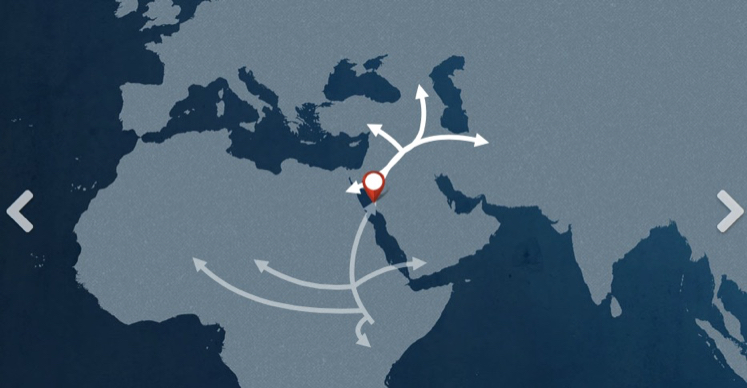
BRANCH: R
AGE: ABOUT 55,000 YEARS AGO
LOCATION OF ORIGIN: WEST ASIA
After several thousand years in the Near East, individuals belonging to a new group called haplogroup R began to move out and explore the surrounding areas. Some moved south, migrating back into northern Africa. Others went west across Anatolia (present-day Turkey) and north across the Caucasus Mountains of Georgia and southern Russia. Still others headed east into the Middle East, and on to Central Asia. All of these individuals had one thing in common: they shared a female ancestor from the N clan, a recent descendant of the migration out of Africa.
The story of haplogroup R is complicated, however, because these individuals can be found almost everywhere, and because their origin is quite ancient. In fact, the ancestor of haplogroup R lived relatively soon after humans moved out of Africa during the second wave, and her descendants undertook many of the same migrations as her own group, N.
Because the two groups lived side by side for thousands of years, it is likely that the migrations radiating out from the Near East comprised individuals from both of these groups. They simply moved together, bringing their N and R lineages to the same places around the same times. The tapestry of genetic lines became quickly entangled, and geneticists are currently working to unravel the different stories of haplogroups N and R, since they are found in many of the same far-reaching places.
POINT OF INTEREST
Descendants of this line dominate the European maternal landscape, making up 75 to 95 percent of the lineages there.

BRANCH: R0
AGE: ABOUT 41,000 YEARS AGO
LOCATION OF ORIGIN: WEST ASIA
Some individuals moved across West Asia into Central Asia and then the Indus Valley. Others moved south, heading back into the African homeland from where their ancestors had recently departed.
Later, members of this lineage moved north across the Caucasus Mountains and west across Anatolia into Europe. These were Cro-Magnon. Their arrival in Europe heralded the end of the era of the Neanderthals.
Today, members of this lineage are present around the Red Sea and widely throughout the region. While this genetic lineage is common in Ethiopia and Somalia, individuals from this group are present at highest frequency in Arabia. Those living in East Africa are the likely result of more recent migrations back into the continent.
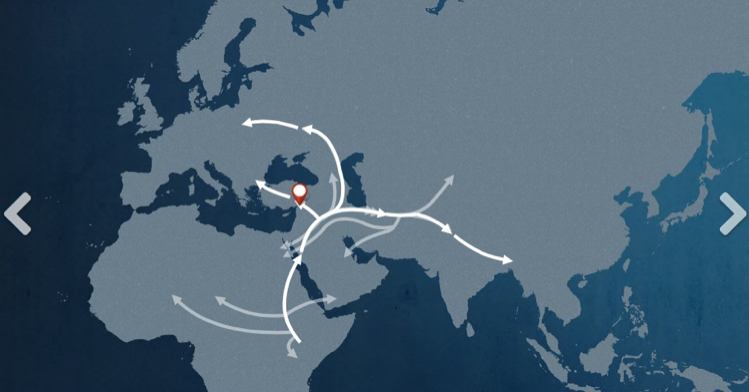
BRANCH: HV
AGE: 22,350 ± 7,745 YEARS AGO
LOCATION OF ORIGIN: WEST ASIA
Descending from haplogroup R were a group of individuals who formed a western Eurasian lineage. The descendants of pre-HV live in high frequencies in the Anatolian-Caucasus region and Iran. While members of this group can also be found in the Indus Valley near the Pakistan-India border, their presence is considered the result of a subsequent migration eastward of individuals out of the Near East.
Individuals in haplogroup pre-HV can be found all around the Red Sea and widely throughout the Near East. While this genetic lineage is common in Ethiopia and Somalia, individuals from this group are found at highest frequency in Arabia. Because of their close genetic and geographic proximity to other western Eurasian clusters, members of this group living in eastern Africa are the likely result of more recent migrations back into the continent.
As we have seen from haplogroups N and R, descendants from these western Eurasian lineages used the Near East as a home base of sorts, radiating from that region to populate much of the rest of the world. Their descendants comprise all of the western Eurasian genetic lineages, and about half of the eastern Eurasian mtDNA gene pool. Some individuals moved across the Middle East into Central Asia and the Hindus Valley near western India. Some moved south, heading back into the African homeland from where their ancestors had recently departed.
Haplogroup pre-HV is of particular importance because over the course of several thousand years, its descendants split off and formed their own group, called HV. This group—thanks in large part to a brutal cold spell that was about to set in—gave rise to the two most prevalent female lineages found in Western Europe.
While some descendants of these ancestral lineages moved out across Central Asia, the Indus Valley, and even back into Africa, your ancestors remained in the Near East. Descending from haplogroup pre-HV, they formed a new group, characterized by a unique set of mutations, called haplogroup HV.
Haplogroup HV is a west Eurasian haplogroup found throughout the Near East, including Anatolia (present-day Turkey) and the Caucasus Mountains of southern Russia and the republic of Georgia. It is also found in parts of East Africa, particularly in Ethiopia, where its presence there indicates recent Near Eastern gene flow, likely the result of the Arab slave trade over the last two millennia.
Much earlier, around 30,000 years ago, some members of HV moved north across the Caucasus Mountains and west across Anatolia, their lineages being carried into Europe for the first time by the Cro-Magnon. Their arrival in Europe heralded the end of the era of the Neanderthals, a hominid species that inhabited Europe and parts of western Asia from about 230,000 to 29,000 years ago. Better communication skills, weapons, and resourcefulness probably enabled them to outcompete Neanderthals for scarce resources. Importantly, some descendants of HV had already broken off and formed their own group, haplogroup H, and continued the push into Western Europe.
Today, members of this line are part of the populations of Europe, West Asia (including Anatolia), and the Caucasus Mountains of South Russia and the Republic of Georgia.
This lineage accounts for around 21 percent of maternal lineages in Armenia. It is about 8 percent of those in Turkey and about 5 percent of those in Croatia. Across much of Europe, this line is present at low frequencies of around 1 percent. This lineage accounts for about 7 percent of the population of both India in South Asia and the United Arab Emirates in West Asia.
POINT OF INTEREST
Some descendant branches that are now part of the populations of East Africa were introduced by the Arab slave trade of the last two millennia.

BRANCH: H
AGE: ABOUT 28,000 YEARS AGO
LOCATION OF ORIGIN: WEST ASIA
This wave of migration into western Europe marked the appearance and spread of what archaeologists call the Aurignacian culture, a culture distinguished by significant innovations in methods of manufacturing tools, standardization of tools, and use of a broader set of tool types, such as end-scrapers for preparing animal skins and tools for woodworking.
Around 15,000 to 20,000 years ago, colder temperatures and a drier global climate locked much of the world's fresh water at the polar ice caps, making living conditions near impossible for much of the northern hemisphere. Early Europeans retreated to the warmer climates of the Iberian Peninsula, Italy, and the Balkans, where they waited out the cold spell. Their population sizes were drastically reduced, and much of the genetic diversity that had previously existed in Europe was lost.
Beginning about 15,000 years ago—after the ice sheets had begun their retreat—humans moved north again and recolonized western Europe. By far the most frequent mitochondrial lineage carried by these expanding groups was haplogroup H. Because of the population growth that quickly followed this expansion, your haplogroup now dominates the European female landscape.
Today haplogroup H comprises 40 to 60 percent of the gene pool of most European populations. In Rome and Athens, for example, the frequency of H is around 40 percent of the entire population, and it exhibits similar frequencies throughout western Europe. Moving eastward the frequencies of H gradually decreases, clearly illustrating the migratory path these settlers followed as they left the Iberian Peninsula after the ice sheets had receded. Haplogroup H is found at around 25 percent in Turkey and around 20 percent in the Caucasus Mountains.
While haplogroup H is considered the Western European lineage due to its high frequency there, it is also found much further east. Today it comprises around 20 percent of southwest Asian lineages, about 15 percent of people living in Central Asia, and around five percent in northern Asia.
Importantly, the age of haplogroup H lineages differs quite substantially between those seen in the West compared with those found in the East. In Europe its age is estimated at 10,000 to 15,000 years old, and while H made it into Europe substantially earlier (30,000 years ago), reduced population sizes resulting from the glacial maximum significantly reduced its diversity there, and thus its estimated age. In Central and East Asia, however, its age is estimated at around 30,000 years old, meaning your lineage made it into those areas during some of the earlier migrations out of the Near East.
Haplogroup H is a great example of the effect that population dynamics such as bottleneck events, founder effect, genetic drift, and rapid population growth, have on the genetic diversity of resulting populations.
Later migrations, such as those during the Neolithic Revolution and those triggered by the Bronze Age, brought additional groups containing different descendant branches of this line to Europe.
POINT OF INTEREST
The highest percentage of this line in Europe is in Ireland, where it makes up 61 percent of the population.
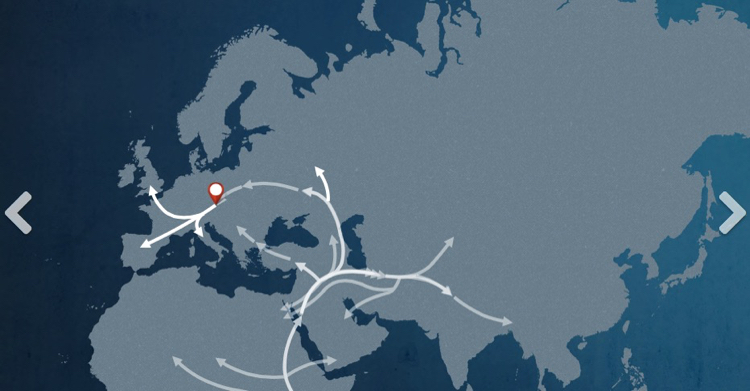
Enter Text
BRANCH: H1
AGE: 9,900 ± 800 YEARS AGO
LOCATION OF ORIGIN: WEST ASIA
From West Asia, this line spread north into Europe and west into West Africa. Descendants of some of those who traveled to Europe expanded out of a southern Europe refugia after the last glacial maximum to recolonize the continent.
Today, this line makes up about 10 percent of maternal lineages in Denmark and around 8 percent of maternal lineages in Norway and Sweden. It accounts for around 9 percent of maternal lineages throughout the British Isles and is 12 percent of maternal lineages in Northern Ireland. It is around 8 percent of the population in Portugal. It is between 4 and 5 percent of maternal lineages in Croatia. It is about 5 percent of the Armenian population and about 6 percent of the Lebanese population.
Note: This branch is not accompanied by a major movement on the map, and research on this branch is continuing.
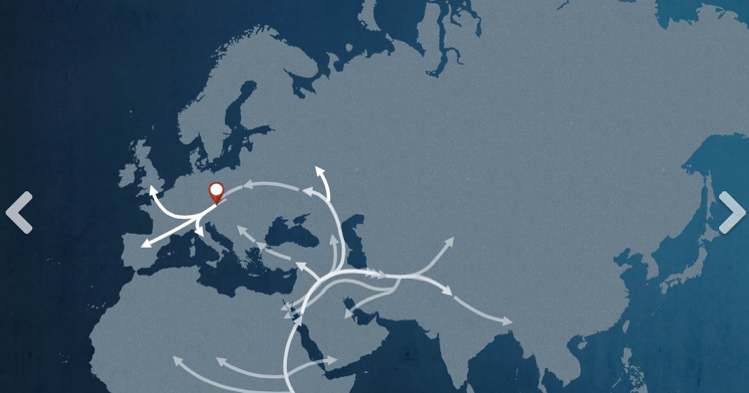
BRANCH: H1E
AGE: TO BE DETERMINED
LOCATION OF ORIGIN: WEST ASIA
Members of this lineage have spread from northern West Asia across Anatolia and into Europe.
Today, this line is present at low frequencies of less than 1 percent throughout Europe and Anatolia. It is 3 to 4 percent of maternal lineages in the Netherlands. It is around 3 percent of the population in Greece and 2 percent of the population of Italy.
This line has a strikingly high frequency of almost 8 percent in some Syrian populations. It is also part of some Jewish Diaspora groups, such as Sephardi and Ashkenazi Jews.
Note: This branch is not accompanied by a major movement on the map, and research on this branch is continuing.
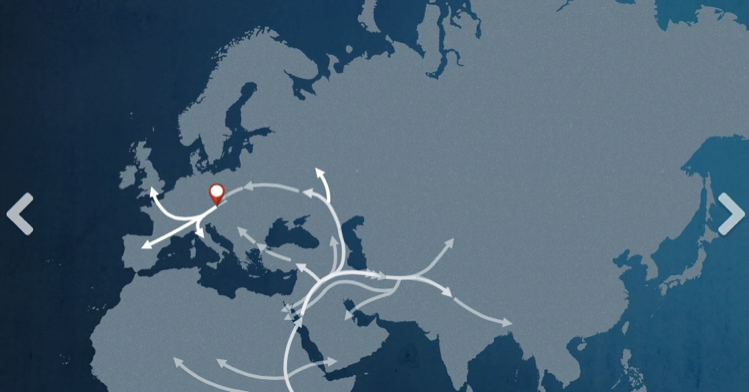
HEATMAP FOR H1
A heat map for your specific haplogroup is not yet available. We hope that as more people from around the world participate in the project we will be able to create a more specific map. We're showing you a heat map for an earlier branch in your path: H1.
This next step in your journey is a map showing the frequency of your haplogroup (or the closest haplogroup in your path that we have frequency information for) in indigenous populations from around the world, providing a more detailed look at where some of your more recent ancestors settled in their migratory journey. What do we mean by recent? It's difficult to say, as it could vary from a few hundred years ago to a few thousand years ago depending on how much scientists currently know about your particular haplogroup. As we test more individuals and receive more information worldwide, this information will grow and change.
The colors on the map represent the percentage frequency of your haplogroup in populations from different geographic regions—red indicates high concentrations and light yellow and grey indicate low concentrations. The geographic region with the highest frequency isn't necessarily the place where the haplogroup originated, although this is sometimes the case.
The map for H1 shows that it is widespread in western Eurasia and North Africa with a peak frequency in Niger, among the Tuareg people, who are a mix of Mediterranean and sub-Saharan African ancestries. A back-migration from Europe or the Middle East accounts for the presence of a typically western Eurasian mtDNA lineage there. Most people with this lineage are from Europe and the Middle East, however, where the highest frequencies are found in Britain, Scandinavia and Russia.
Does this mean you're related to people in the areas highlighted on your map? Distantly, yes! We are all connected through our ancient ancestry.
NEXT STEPS
Your results shown here are based upon the best information available today—but it is just the beginning. As we learn more, we may add new markers to your path, or modify your results to be more specific over time.
DNA markers require a long time to become informative. While mutations occur in every generation, it requires at least hundreds—normally thousands—of years for these markers to become windows back into the past, signposts on the human tree.
A fundamental goal of the Genographic Project is to extend these arrows further toward the present day. To do this, Genographic has brought together renowned scientists and their teams from all over the world to study questions vital to our understanding of human history. By working together with indigenous peoples around the globe, we are learning more about these ancient migrations.
WHO AM I?
We are all more than the sum of our parts, but the results below offer some of the most dramatic and fascinating information in your Geno 2.0 test. In this section, we display your affiliations with a set of nine world regions. This information is determined from your entire genome so we're able to see both parents' information, going back six generations. Your percentages reflect both recent influences and ancient genetic patterns in your DNA due to migrations as groups from different regions mixed over thousands of years. Your ancestors also mixed with ancient, now extinct hominid cousins like Neanderthals in Europe and the Middle East or the Denisovans in Asia. If you have a very mixed background, the pattern can get complicated quickly! Use the reference population matches below to help understand your particular result.
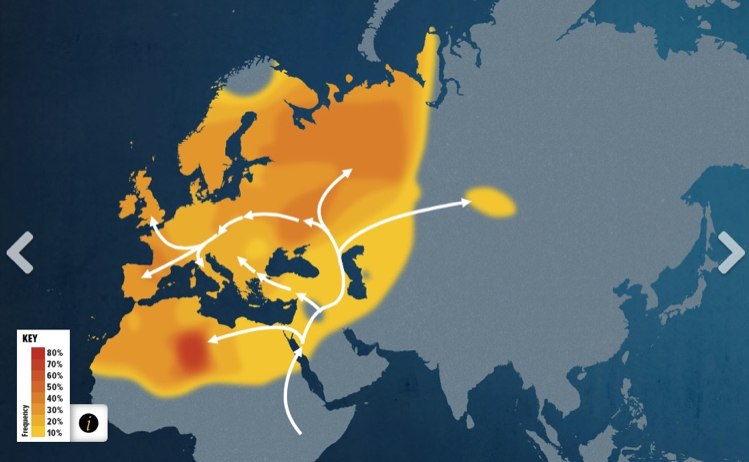
The Brashears DNA results below reveal the location of our most recent ancestors over the last 1,000 years or so. This testing was done through Ancestry.com.
Unlike the Y-chromosome or mitochondrial DNA test, AncestryDNA uses an autosomal DNA test that surveys a person’s entire genome at over 700,000 locations. It covers both the maternal and paternal sides of the family tree, so it covers all lineages. The Y-DNA test only reflects the direct father-to-son path in your family tree, and the mtDNA test only reflects the direct mother-to-child path in your family tree. Learn more about the differences between the DNA tests here.
The test is gender neutral. Both men and women can take the AncestryDNA test and are tested in the same way for the same number of markers providing the same level of detail in the results.
It predicts your recent genetic ethnicity. Thanks to advances in DNA technology we’re able to compare your DNA to samples from around the world, to find out more about your family’s background and ethnic history—not ancient history, but the people and places that matter to you.
Enhanced DNA matching. Unlike the Y-chromosome or mitochondrial DNA tests, the new AncestryDNA autosomal test looks at a much broader range of your DNA, which helps identify matches throughout your entire family tree—along both your paternal and maternal sides.
The information is more relevant and recent—targeting your family history a few hundred or even a thousand years ago, as compared to the Y and mtDNA tests, which have a 10,000 to 50,000 year time focus.
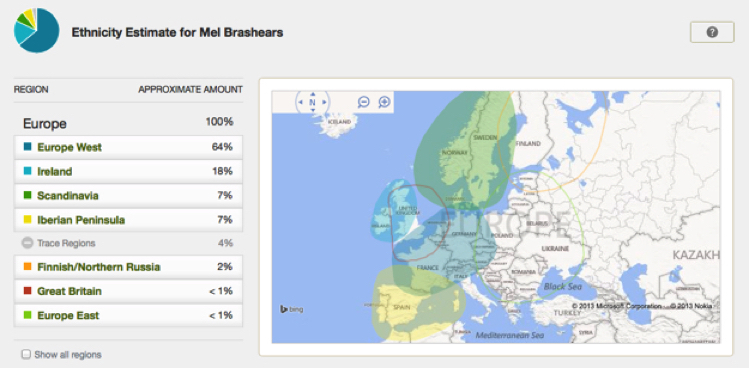
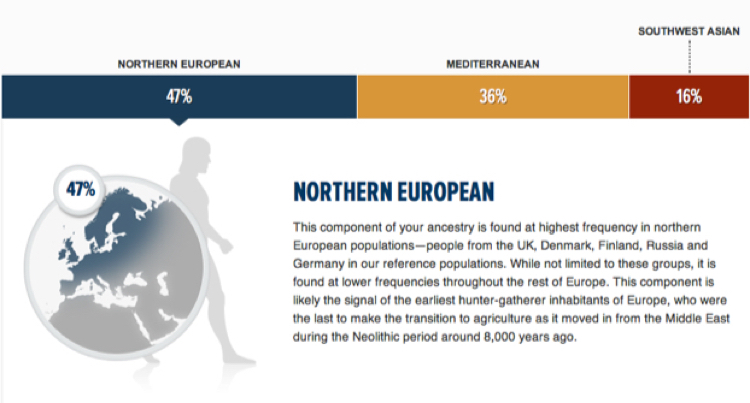
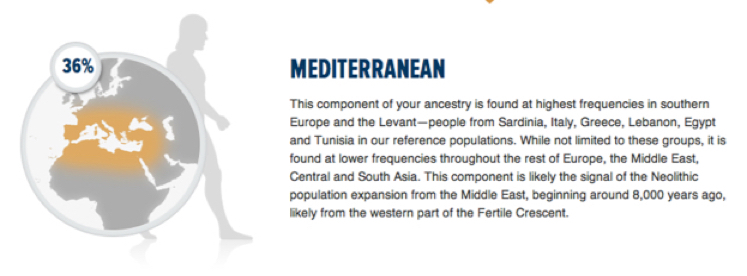
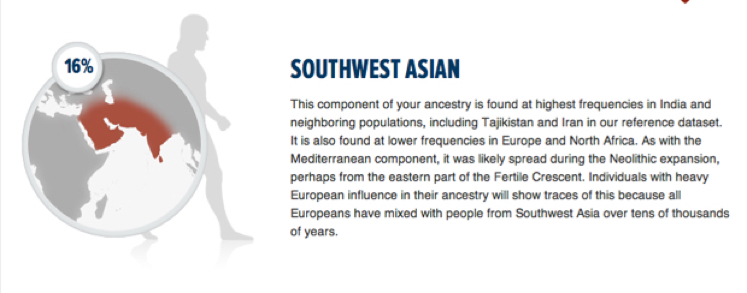
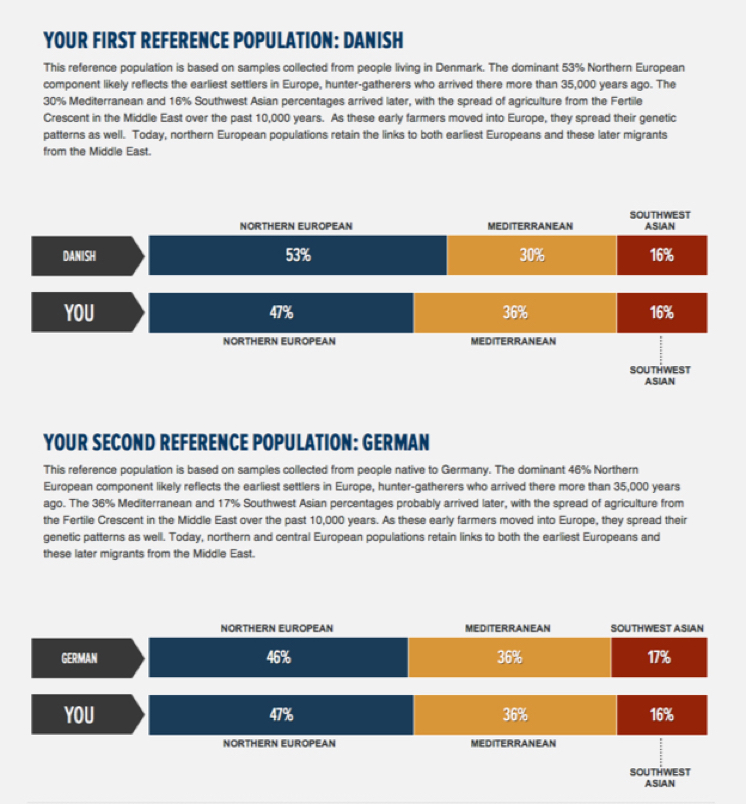
Update Reference Populations in 2018
Melvin Richard Brashears

